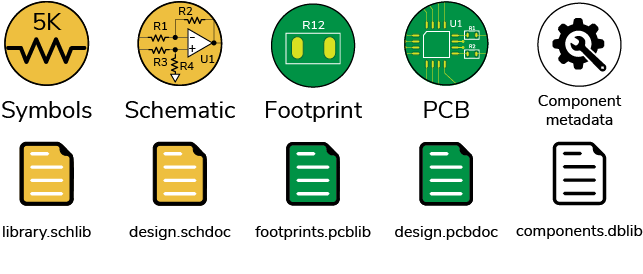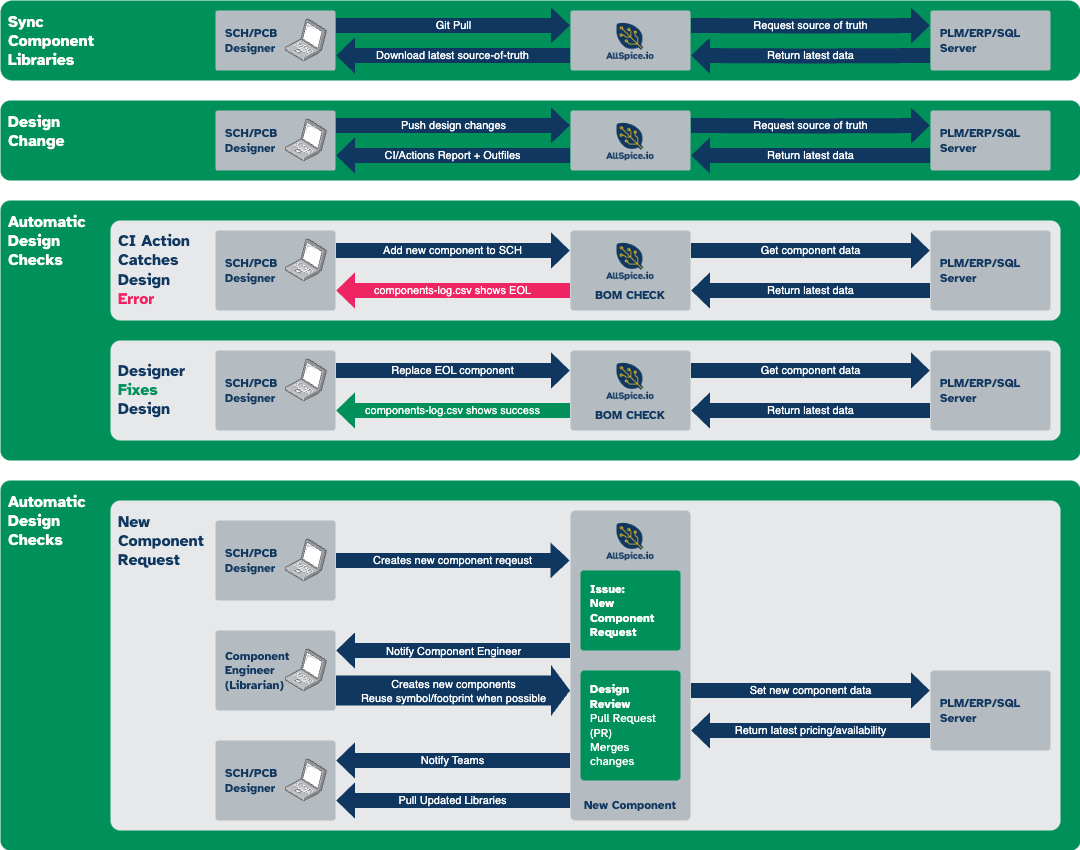Types of Library Management
The following categories are listed least-to-most sophisticated, but most businesses pick and choose a minimal mix of all of these.
In-file design Libraries
Most organizations start with an in-file design library. It’s often fully integrated into the schematic, PCB, and ECAD project files. This works for most smaller organizations as the overhead of managing a few PCBs per year is enough for a single engineer.
Pros | Cons |
|---|---|
Gratis (free as in lunch) and Libre (free as in licensing) | All of the work, every time |
Flexible | Fully manual |
Easy for teams without purchasing/planning | Mistakes get propagated |
Different PCBs have different component data | |
Designs diverge every PCB revision | |
The longer you wait to organize, the more work it is to fix your components |
Ad hoc library: symbol and footprint files
Separating the symbol and footprint information from the schematic and PCB files allows them to change independently of the PCB design. Without version control, centralization and a more formal process, these libraries often have the same problems as no libraries. Designers often go rogue and make their own libraries, defeating the purpose of having external library files.

Version controlled library files
Version controlling external library files is such an easy and productive process to adopt, that it should be one of the first operations when starting a PCBA design. The design delays and production issues with component errors is worth the ROI on starting a minimal version controlled component library.
Version control allows you to do small daily steps to incrementally improve your libraries.
Here is an example workflow where a design engineer needs a new component, like an LVDS clock driver.

Version controlled library best practices
Separate files for component categories
They all have their own complexities
Smaller changes more often
Separate resistors from capacitors
Semiconductors by type
Microcontroller/microprocessor/FPGA/etc
RAM
Logic
Power
RF
Hardware by type
Connectors
Cables
Externals (i.e. SD card, battery, antenna)
Fasteners
Operations
Barcodes (2D, Matrix)
Stickers
Laser markings
Challenges of simple version controlled libraries
Component ordering attributes are often still embedded in the symbol files at this point. They have to be manually exported and then massaged into a format manufacturers can use. Even if the information is in separate “integrated library” files or database, there is often a manual and error-prone process involved.
CI controlled libraries
With the addition of Continuous Improvement (CI) Action Runners, you are able to bolt-on an automated component librarian:
Never sleeps, never sick, always sharp, never gets distracted
Follows process exactly
Fetches component data
Extended BOM + COGS
Single and multiple quantity scenarios
Availability and lead time
Generate fast/slow PCB assembly turnaround build plans
Automatic component alerts
Price changes
Lifecyle changes (End of life, NRFND)
Low quantity
Long lead-time
Generates where-used and usage data
Syncs with PLM and ERP systems
AllSpice.io → PLM/ERP
PLM/ERP → AllSpice.io
AllSpice.io ←→ PLM/ERP
Syncs with common databases
Relational: SQL, MySQL, MariaDB, PostGress, SQL Lite
Non-relational: NoSQL, MongoDB
GraphDB
Knows every programming language and framework
Works with existing tech stack
Python/Mojo/Django
C/Rust
Javascript/Ruby
Anything supported by Ubuntu 2024 LTS
Here are some CI workflow diagrams

CI Actions
CI is easy to understand. It’s a separate server that spins up a fresh software container (like Docker) and then runs any program in any programming language that you want.
Run Checks
Connect to external APIs to write or fetch data
Generates files (BOM, Drill, XY, FAB)
Generates documentation (compliance, utility, history)
To learn more, visit our Actions CI/CD page.